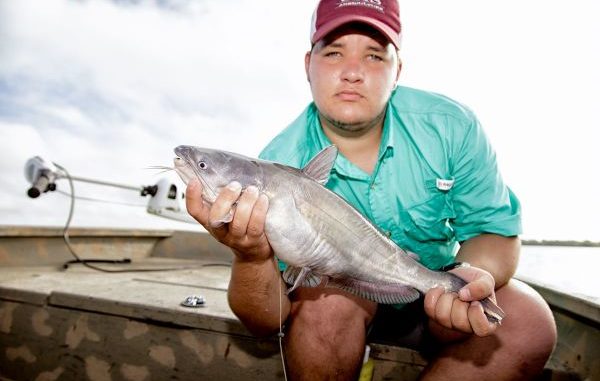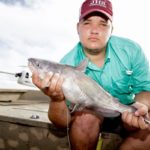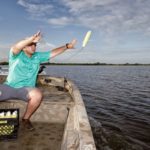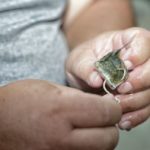
It’s hard to beat jugs when targeting catfish, and this Southwest Louisiana angler has it down to a science. Discover the tricks he’s learned.
I grew up beside a catfish pond.
The simplistic pleasure of watching a cork getting pulled under stuck with me.
Although largemouth bass bullied their way to the top of my most-wanted list, I never lost my love of watching a cork while wondering when it was going to disappear.
My only problem with fishing catfish with a cork was that I just couldn’t let it sit still long enough.
At least that’s what my grandfather pointed out every time we went fishing.
I had to have some action. If the catfish didn’t want to play, I just provided my own entertainment by popping my cork and watching it quiver on the surface.
“What? You got ants in your pants?” my grandfather would ask. “You ain’t ever gonna catch anything if you don’t let it sit.”
But the only way I could let a cork sit was by casting it out and walking away.
In that way, Mike Lantz and I aren’t all that different — only, he walks away from 30 corks while I could hardly manage to walk away from one.
Lantz, affectionately known as “Noose” (a modified version of papoose that his father used to call him), grew up fishing jugs for catfish, but it wasn’t until maybe seven or eight years ago that he started to take jug fishing more seriously.
Although Lantz professes to be no jug-fishing expert, he has learned through trial and error in that time how to build a better jug, thus making him a better jug fisherman.
He picked me up from my motel room in Jennings at 4:30 in the morning for the 20-minute drive down to the lower Mermentau River basin — he wanted to be there early enough to catch some perch to use for bait.
“I like to use cut bream for bait,” Lantz told me as we started down Highway 26 toward Lake Arthur, “but we’ve got to catch them on a rod and reel since we can’t run a trap for them.
“We’ll try to get a dozen or so real quick, then get our jugs out.”
While launching his boat at Gary’s Landing, I couldn’t help but notice Lantz didn’t have any jugs in his boat. Since we were jug fishing, I had to ask him about our obvious lack of what I thought were necessary items.
He pointed out a milk crate filled with approximately 30 yellow pool noodles.
“I used to use jugs,” Lantz said, “but they take up so much room. When you get 30 milk jugs in a boat, you’ve got a boat full of jugs.
“I read about people making some like these a few years ago, and sat down and started building my own.”
Lantz’s fabricated “jugs” are nothing more than a ½-inch pieces of PVC pipes inserted into yellow pool noodles with 2 ½-foot pieces of string.
Lantz turned his boat into Streeter’s Bayou and eventually allowed his boat to settle into the water near an island in the back of a dead-end canal. He and his son Dylan threaded pieces of cold worms onto their bream hooks.
After figuring out the bream were farther off the bank and a little deeper than he originally thought, Lantz started cutting up the eight we had into little chunks of catfish bait.
“Might as well go ahead and get this show on the road,” he said. “We’ll go set out 20 and come back to see if we can catch some more bream.”
Normally, when he has enough bream from his initial stop, Lantz sets out his jugs and goes bass fishing for an hour or two while they work their magic.
“That’s kind of how I started with this jug fishing,” he explained. “I’d set them out sort of as a trip saver. If I had a slow day of bass fishing, I’d check them on my way in and wind up with 10 to 12 good catfish.”
What was once a back-up plan has now turned into his first plan.
The water was a little high and muddy from several days of heavy rain, but Lantz believed the cards we were dealt would stack the odds in our favor.
“It’s generally better with the water up because my jugs have an easier time drifting, and catfish seem to be up the flats a little more,” Lantz said.
After checking the wind direction, Lantz moved toward the eastern side of a flat that had a channel running through it, and Dylan Lantz started baiting and heaving the 20 homemade jugs into the water.
“If you want to do this on your home water,” Lantz said, “try looking for flats along main bayous. Anywhere you can find some flats in 2 or 3 feet of water with a channel or two you’ll find feeding catfish.”
By the time Dylan Lantz had tossed out the last jug, I was already curious to run back to the beginning of the line to see if we had a fish.
“Patience,” Lantz advised. “Let’s go catch us some more bream so we can rebait these when we come back to check them.”
The line of yellow pool noodles looked like some kind of cork cavalcade as we idled away.
Lantz prefers cut bream because he tends to catch a lot of blue cats with a few channel cats and a willow cat or two somewhere in the mix.
“I feel more confident with cut bait than I do with anything else,” he said, as he started filling his livewell with some more bream. “These blues aren’t as finicky as the Ops are, and the smell of this cut bait in this dirty water — I’ve just had good success with it.”
I couldn’t take it anymore.
Those jugs had been sitting out there for at least 30 minutes, and I just knew we should go check them.
“Think we ought to go check them?” I innocently asked while repressing years of deep-rooted desire to yank on a cork.
“We got to give then at least an hour,” Lantz responded, with a feeble attempt to control his own curiosity.
Fifteen minutes later, we pulled up to the first jug that was obviously being jerked around by a catfish.
I had wondered earlier how we would know if a catfish had taken the bait. Now, watching our first jug standing fully erect in the water, I could tell there was no mistaking it.
“As you can see, they’ll stand up,” Lantz said. “They’ll also travel a little bit as the catfish tries to swim away from an approaching boat.
“I’ve had some take them under for a few minutes, but we just wait for them to pop back up if they do.”
Although we hardly sniffed Lantz’s best day from last summer — 21 catfish up to 20 pounds that filled a 170-quart ice chest — we were able to put 14 fish in the box.
While we searched for wayward jugs, Lantz told me about the allure of jug fishing for catfish. For him, the draw is how much more interactive jug fishing is than using rods and reels, limb lines or trot lines.
“There’s always something to do,” he said. “Whether you’re catching bait in the morning, throwing out the jugs, landing fish, chasing jugs — everybody on board gets involved.
“That’s especially good if you’ve got kids with short attention spans.”
Jug fishing also has the added benefit of covering a lot of water quickly to find actively feeding fish. For me, it was kind of like the difference between fishing a crankbait versus a worm for bass: A worm is more for targeting bass on a specific piece of cover, whereas a crankbait combs water quickly to find actively feeding fish.
As Lantz put it, why fish with one pole when you could fish with 30?
“Thirty jugs is just right for me,” he said. “That’s plenty to get on some fish. That’s not so many that you get tired of baiting them, setting them out or picking them up, but it’s enough to make sure you cover a big flat and catch some fish.”
Although he won’t say he catches catfish every time he jug fishes, Lantz conceded it’s been a long time since he set his jugs out and not come home with something.
After loading his boat on its trailer back at Gary’s, I had to admit to Lantz that I was hooked on jug fishing.
“Seems like the best of both worlds,” I told him. “You get the experience of fishing with a cork, but you don’t have to put up with sitting there waiting on it to go under.”
Set them out, go find something else to occupy your mind, come back and check them later.
Sounds like the perfect way to fish for anybody with ants in their pants.




